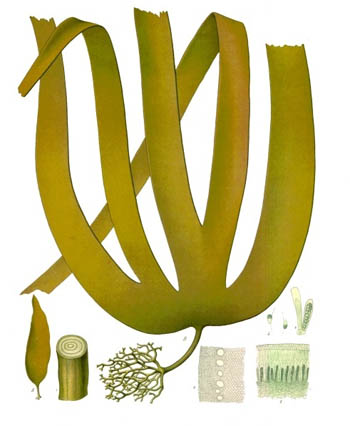The ecological consequences of industrial kelp harvesting
 Marine
Marine  Laminaria, a genus of brown algae common called "kelp."Kelp forests provide important habitat for numerous invertebrates, fish, birds and marine mammals. The ecological consequences of industrial harvest of this habitat has not been fully evaluated.
Laminaria, a genus of brown algae common called "kelp."Kelp forests provide important habitat for numerous invertebrates, fish, birds and marine mammals. The ecological consequences of industrial harvest of this habitat has not been fully evaluated.
The removal of feeding and nursery grounds of coastal predatory fish, may influence local food webs and the availability of food to top predators such as seabirds.
A recent study has demonstrated that there is justified cause for concern. The study revealed that the removal of these habitats has multi-trophic effects.
In central Norway the kelp harvesting industry focuses on the nearshore Laminaria dominated kelp forests. The kelp is harvested with a dredge pulled by a boat along the bottom, which rips the plants from the rock. This harvesting technique removes all canopy-forming kelp plants in a 4-m wide track. ROV footage reveals almost complete removal of cover.
Researchers Svein-Håkon Lorentsen, Kjersti Sjøtun, and David Grémillet hypothesized that this removal of habitat will result in changes in juvenile cod abundance and will ultimately have an effect on the cormorant foraging trip frequency and productivity within areas of kelp harvest.
The study started by mapping the seafloor including all kelp beds and the total area of all cormorant feeding areas. The researchers assessed kelp removal and performed fish counts using remote operated vehicles. Individual birds were equipped with radio transmitters and details of foraging trips were recorded for month long trials.
Balances were installed under the nests to determine the amount of food caught on each foraging trip. Catch per unit effort (CPUE g/min) for each foraging trip was estimated using the ratio of the amount of food caught per trip (from the nest balances) to the time spent underwater per foraging trip (from the radio-tracking data).
The researchers found that the abundance of small fish in the harvested areas was 90% less than abundance in un-harvested areas (>50% kelp cover). In areas that had been harvested in the previous season (1 year earlier) there was 85% less small fish than in the un-harvested areas. The abundance of large adult fish saw no difference between harvested and un-harvested areas.
Cormorant dives were strongly correlated with kelp cover and showed a strong association with the un-harvested areas, significantly fewer dives were preformed during foraging trips in the un-harvested areas.
Foraging success in harvested areas was less than half of what it was in un-harvested areas. The CPUE was much higher in un-harvested areas. This all means that cormorants chose more often to forage in un-harvested areas as it was easier to catch more fish.
This study reveals that there should be some concern regarding the potential bottom up effects of the kelp harvesting industry.
The kelp harvest in Norway is managed to maximize the biomass harvested per year with little consideration for ecological effects. Locations are harvested every five years and it has been shown that kelp has not reached its maximum size in this time. Cod has been designated as endangered and is on the Norwegian red list. This study justifies more research into the evaluation of ecosystem effects of such practices.
--by Jason Thompson
Lorentsen, S., Sjøtun, K., & Grémillet, D. (2010). Multi-trophic consequences of kelp harvest Biological Conservation, 143 (9), 2054-2062 DOI: 10.1016/j.biocon.2010.05.013




Reader Comments